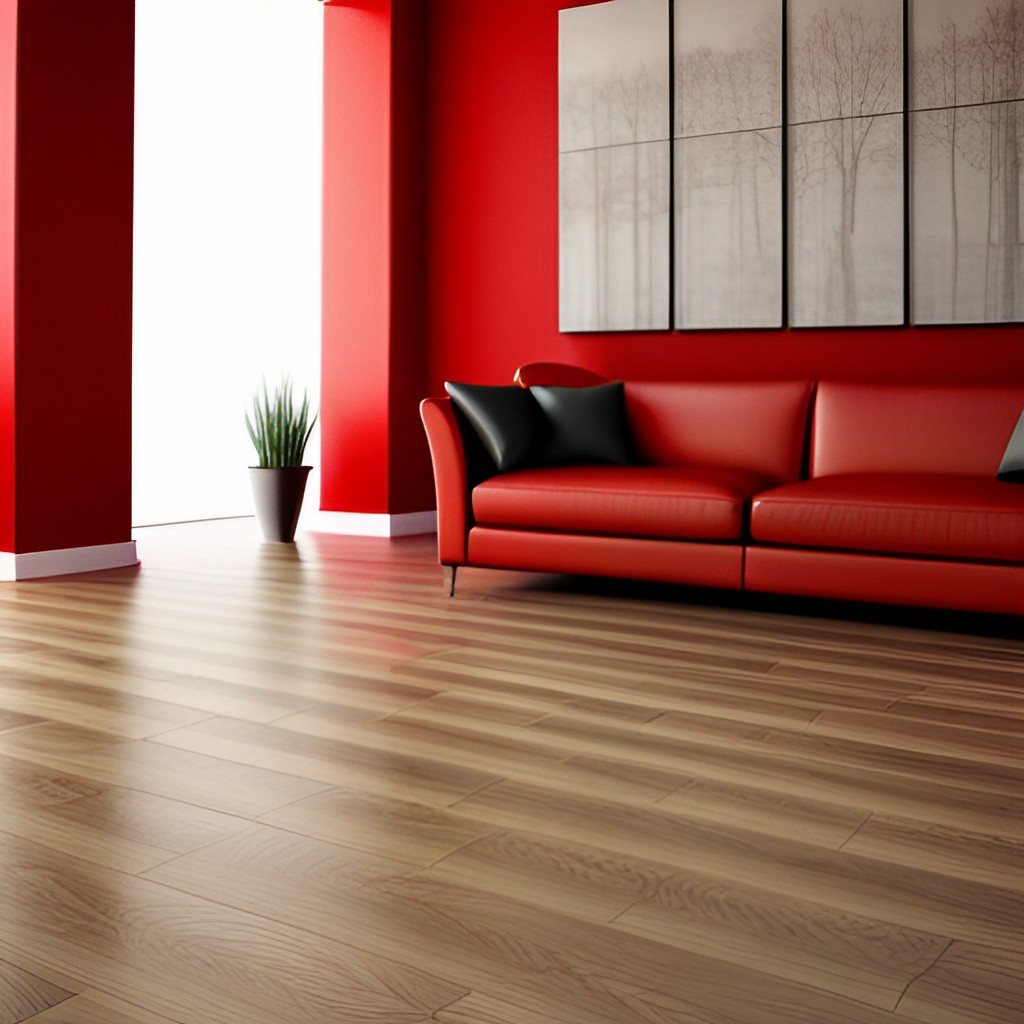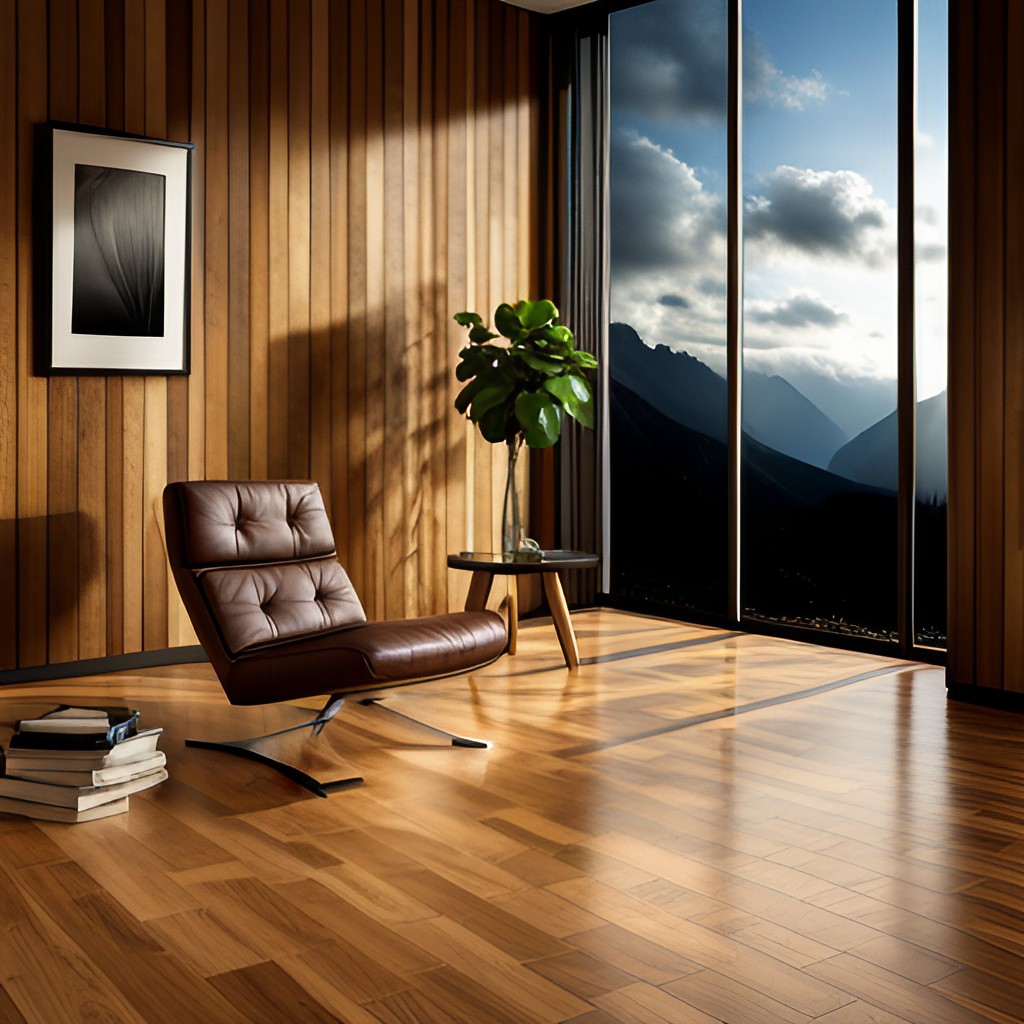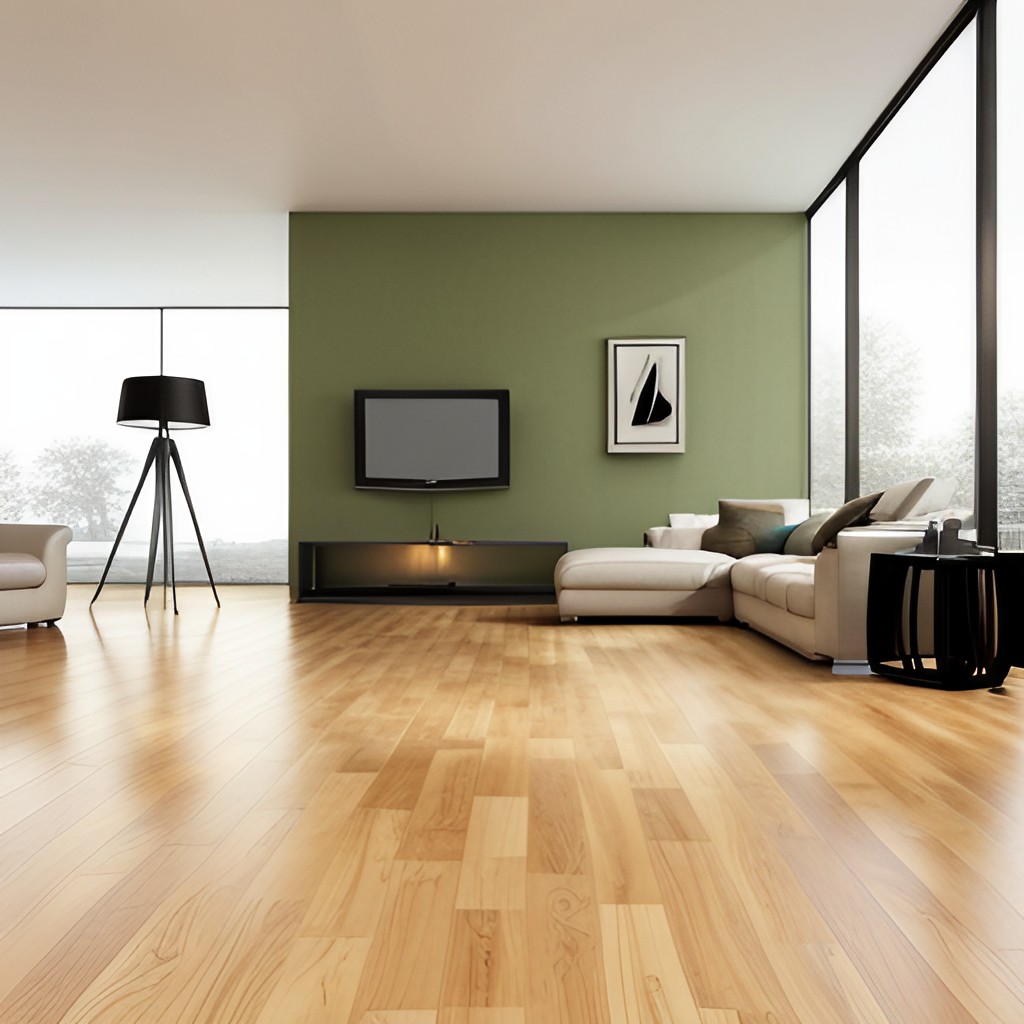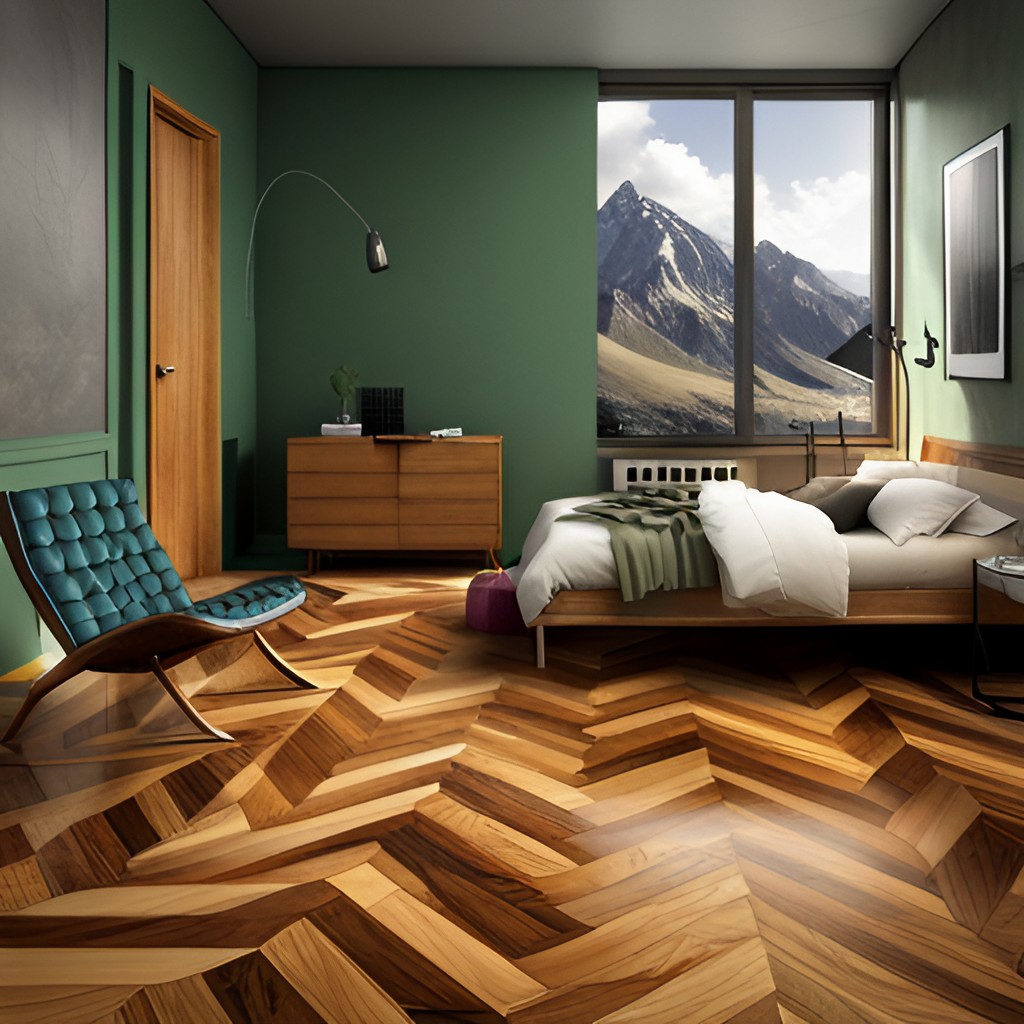Bamboo flooring emerges as a sustainable and eco-friendly alternative to traditional hardwood flooring, marking a significant stride in green building trends. This flooring option harnesses the rapid growth rate of bamboo, a type of grass, which reaches maturity in as little as three to five years far quicker than hardwood trees, which can take twenty years or more.
Bamboo’s robustness, durability, and aesthetic versatility not only offer a practical solution for homes and commercial spaces but also contribute positively to the environmental quest for renewable resources.
Its cultivation and harvesting processes have a reduced carbon footprint, further cementing bamboo flooring’s position in the realm of sustainable architecture and design.
Rapid Growth Rate

Growth Cycle Comparison
Bamboo’s standout growth cycle sets it apart from traditional hardwoods. While hardwood trees such as oak or maple may take decades to mature fully, bamboo achieves full growth and can be harvested within a mere 3 to 5 years.
This astonishing growth rate is a fundamental aspect of its sustainability; bamboo can be replanted and harvested repeatedly without causing significant harm to the ecosystem.
In contrast, once a hardwood tree is cut down, the loss is felt for decades, significantly impacting the forest’s ability to sequester carbon. Additionally, bamboo has the ability to regenerate itself from its own root system after cutting, eliminating the need for replanting.
This cycle ensures a continuous and sustainable supply of bamboo, minimizing deforestation and the depletion of biodiversity associated with traditional hardwood logging.
Regenerative Harvesting
One of the most remarkable attributes of bamboo is its ability to be harvested without killing the plant. Unlike traditional hardwood forests where trees are cut down, leaving empty spaces that take decades to refill, bamboo’s harvesting process is non-destructive.
This is because bamboo plants have a unique rhizome-dependent system that allows them to regenerate and grow back after being cut. This capability not only ensures the plant’s survival but also allows for quicker regeneration, typically seeing new shoots emerge within weeks.
Consequently, this method sustains the bamboo forests’ density and ecosystem services without interruption, promoting a cycle of renewal that traditional hardwood harvesting cannot replicate.
This regenerative feature of bamboo underpins its sustainability and environmental friendliness, making it an increasingly preferred material in green architecture and eco-conscious design projects.
Environmental Impact
Carbon Sequestration
Bamboo not only grows at an astonishing rate but also plays a significant role in the fight against climate change through its exceptional ability to sequester carbon.
This rapid growth allows bamboo to absorb carbon dioxide from the atmosphere at a faster rate compared to many other plant species, including hardwood trees.
In fact, bamboo can sequester up to four times more carbon dioxide per year and release 35% more oxygen, thereby contributing significantly to carbon offsetting. Its dense growth helps in creating a microenvironment that further enhances its capacity for carbon sequestration.
This feature, combined with its sustainable harvesting practices, positions bamboo as a pivotal resource in efforts to reduce carbon footprints and mitigate global warming.
The low carbon footprint associated with bamboo cultivation and its end products underscores bamboo’s credentials as a green and eco-friendly material for a wide range of applications.
Deforestation Mitigation
By providing a sustainable alternative to hardwood flooring, bamboo significantly reduces pressure on deforestation. Traditional hardwood flooring requires the felling of mature trees, which can take decades to regenerate, leading to the degradation of forests and loss of biodiversity.
In contrast, bamboo’s rapid growth cycle and the ability to harvest without killing the plant make it a highly renewable resource.
Consequently, the adoption of bamboo flooring and other bamboo-based products can lead to a decrease in the demand for hardwood, thereby helping to preserve the world’s forests.
This shift not only supports the conservation of ecosystems but also aids in maintaining the balance of oxygen and carbon dioxide in the atmosphere. Therefore, bamboo stands out as an eco-friendly choice that promotes environmental sustainability while reducing the exploitation of hardwood resources.
Durability and Longevity

Durability Comparison
Bamboo flooring is renowned for its exceptional durability and strength, rivaling and often surpassing traditional hardwood floors. When properly treated, bamboo floors can withstand wear and tear, making them suitable for high-traffic areas.
Unlike some hardwoods, bamboo has a natural resistance to moisture and insects, which contributes to its longevity. This resilience is partly due to the dense fibers in bamboo, which provide a hard surface that resists indentations and scratches better than softer wood varieties.
In comparison, materials like carpets or vinyl flooring may offer comfort and stylistic versatility but fall short in terms of lifespan and resilience against physical damage.
Consequently, bamboo emerges as a superior choice for homeowners seeking a balance between aesthetic appeal and long-term durability.
Pest and Moisture Resistance
Bamboo’s natural resistance to pests and moisture significantly contributes to its appeal as a durable flooring option. This resistance is inherent, requiring no additional chemical treatments to fend off common threats such as termites or mold growth.
The bamboo plant’s fibers are tightly packed, creating a structure that is less inviting to insects and less susceptible to water damage compared to other natural materials.
This characteristic ensures that bamboo flooring remains stable and intact in varying environmental conditions, making it a practical choice for areas prone to humidity or spills.
The ability of bamboo to naturally repel these common issues not only enhances its durability but also promotes a healthier living environment by minimizing the need for potentially harmful pesticides and mold treatments.
Eco-friendly Manufacturing Process

Low-VOC Adhesives
The production of bamboo flooring also takes into consideration the environmental impact of adhesives used in its manufacturing. Specifically, the use of low-VOC (Volatile Organic Compounds) adhesives plays a critical role.
These adhesives significantly minimize the emission of harmful chemicals into the environment and indoor air, contributing to healthier living spaces and reducing pollution.
By opting for low-VOC adhesives, manufacturers not only adhere to stricter environmental standards but also ensure that the final product is safer for consumers, highlighting bamboo flooring as an eco-conscious choice.
This approach underscores the commitment to sustainability and health, which is central to the eco-friendly ethos of bamboo flooring production.
Sustainable Harvesting Advances
Advancements in sustainable harvesting and processing techniques have significantly bolstered the environmental credentials of bamboo flooring. Modern practices ensure that bamboo is harvested responsibly, typically using methods that promote rapid regrowth and prevent soil erosion.
These techniques allow for the bamboo to be cut without harming the root system, enabling it to rejuvenate faster than hardwood trees.
Furthermore, the processing of bamboo into flooring now increasingly employs eco-friendly methods that reduce energy consumption and waste.
Innovations such as the use of solar energy in manufacturing and water recycling systems exemplify the industry’s commitment to minimizing its carbon footprint. This progressive approach ensures the bamboo flooring sector remains at the forefront of sustainable development.
Economic Benefits
Job Creation
Cultivating bamboo has a notable impact on job creation, especially in regions where economic opportunities may be limited. The increased demand for eco-friendly bamboo flooring not only supports existing agricultural jobs but also fosters new employment opportunities in both the farming and manufacturing sectors.
Local communities benefit from the growth of the bamboo industry, as it requires labor for planting, maintaining, and harvesting the bamboo, along with skilled workers for processing and converting bamboo into flooring products.
This cycle of growth and manufacture, deeply intertwined with sustainable practices, bolsters local economies and provides stable income sources, contributing significantly to rural development.
Cost-Effectiveness
For consumers aiming to invest in durable, sustainable flooring, bamboo stands out not only for its environmental benefits but also for its cost-effectiveness. Initially, the price of bamboo flooring may appear comparable to that of traditional hardwood floors.
However, considering its longevity and lower maintenance costs, bamboo flooring has become an economically viable option over time.
Its natural resistance to moisture and pests reduces the need for frequent replacements and repairs, thus offering substantial savings in the long run.
Additionally, as bamboo flooring gains popularity, competitive market pricing and a wide range of options make it an accessible choice for various budget ranges, further emphasizing its viability as a cost-effective flooring solution.
Versatility and Aesthetic Appeal

Styling Versatility
Bamboo flooring is celebrated for its impressive versatility in styles, colors, and finishes, making it an ideal choice for a wide range of decor themes. From the natural and rustic to the sleek and modern, bamboo can be processed and finished in numerous ways to suit any aesthetic preference.
Manufacturers employ different techniques to achieve a spectrum of colors, from natural light wood tones to richer, darker shades.
Finishes can vary as well, including matte, semi-gloss, and high-gloss options, along with hand-scraped or distressed textures.
This flexibility enables homeowners and designers to seamlessly incorporate bamboo flooring into various interior design schemes, ensuring that each space can reflect personal style while benefiting from bamboo’s sustainable and durable qualities.
Refinishing Flexibility
One distinct advantage of bamboo flooring is its ability to be refinished, which substantially extends its lifespan and refreshes its appearance. Over time, floors inevitably show signs of wear and tear, but bamboo flooring can be sanded down and resealed, much like traditional hardwood.
This process can erase years of scratches, dents, and discoloration, making the floor look brand new.
Additionally, refinishing offers an opportunity to update the floor’s finish or change its color, aligning with evolving design trends or personal taste changes.
This capability not only enhances the bamboo floor’s aesthetic appeal but also contributes to its sustainability by reducing the need for replacement.
Related Topics:
Challenges and Considerations
Sustainability Certification
Choosing bamboo flooring that is certified for sustainable forest management practices is crucial in ensuring environmental responsibility.
Certifications such as the Forest Stewardship Council (FSC) offer reassurance that the bamboo was harvested sustainably, maintaining the balance of ecosystems and promoting the well-being of local communities.
Such certifications also indicate that the manufacturing processes adhere to strict environmental standards, minimizing the carbon footprint and ensuring that practices like chemical use are closely regulated.
Opting for certified bamboo flooring supports global conservation efforts, aids in the fight against deforestation, and encourages the responsible management of natural resources.
By selecting certified products, consumers play a part in advocating for a greener planet and sustainability in the industry.
Variability in Quality
The quality of bamboo flooring can significantly vary depending on the manufacturer and the source of the bamboo. Factors such as the age of the bamboo at harvest, the conditions in which it was grown, and the manufacturing processes employed play crucial roles in determining the floor’s durability and appearance.
Younger bamboo is less durable than mature bamboo, which has had more time to develop its strength. Additionally, the methods used to cut, dry, and press the bamboo into flooring planks can affect the product’s stability and resistance to moisture and wear.
Therefore, it’s important for consumers to research and select manufacturers with a reputation for high-quality products and transparent sourcing practices.
This diligence helps ensure the bamboo flooring’s longevity and performance over time, safeguarding the investment in one’s home.
Conclusion
Bamboo flooring stands as a testament to the power of sustainable living, marrying aesthetic beauty with environmental responsibility. Its incredible rapid growth rate, coupled with the ability to regenerate and be harvested repeatedly without causing significant harm to the ecosystem, positions bamboo as a superior, eco-friendly alternative to traditional hardwood floors.
Not only does its cultivation and use contribute less to global carbon emissions, but it also plays a crucial role in the fight against deforestation by offering a viable and sustainable option.
The industry’s commitment to low-VOC manufacturing processes and sustainable harvesting techniques further enhances bamboo flooring’s green credentials, making it an ideal choice for eco-conscious consumers.
With its impressive durability, cost-effectiveness, and a wide array of styles, bamboo flooring not only meets the aesthetic and functional needs of modern living spaces but also aligns with the pressing demand for sustainable development.
In essence, bamboo flooring is not just a product but a choice for a more sustainable and green future, demonstrating that we do not have to compromise on quality or beauty in our quest for environmental sustainability.
FAQs
How does bamboo flooring compare to traditional hardwood in terms of durability?
Bamboo flooring is renowned for its exceptional durability and strength, often outperforming traditional hardwood floors. The manufacturing process, which involves compressing bamboo fibers under high pressure, results in a dense, hard material that can withstand considerable wear and tear.
Certain types of bamboo flooring, like strand-woven bamboo, are particularly resistant to scratches and dents, making them suitable for high-traffic areas and homes with pets or children.
Is bamboo flooring suitable for areas with high moisture levels?
While bamboo is more moisture-resistant than many types of hardwood, it is not entirely waterproof. Therefore, caution should be exercised when installing bamboo flooring in areas prone to high moisture, such as bathrooms or basements.
However, certain engineered bamboo flooring options have been designed to increase moisture resistance, making them a more viable choice for those areas. Always consult the manufacturer’s recommendations before installation in moisture-prone areas.
Can bamboo flooring be refinished?
Yes, bamboo flooring can be refinished, breathing new life into the surface and extending its lifespan. However, the ability to refinish bamboo flooring depends on the thickness of the planks and the material’s construction. Solid bamboo floors offer more flexibility for refinishing compared to thinner, engineered options.
Typically, strand-woven bamboo can be sanded down and refinished multiple times, similar to traditional hardwood floors. It is advisable to consult with a flooring professional to assess the refinishing potential of your specific bamboo flooring.

4 thoughts on “6 Reasons How is Bamboo Flooring Sustainable”